A Terrestrial Laser Scanning-Based Method for Indoor Geometric Quality Measurement
Abstract
:1. Introduction
2. Related Works
2.1. Data Acquisition
2.2. TLS-Based Geometric Quality Detection
3. Proposed Automated Indoor Geometric Quality Assessment Method
3.1. Data Acquisition and Preprocessing
3.1.1. Coordinate Transformation
3.1.2. Down-Sampling
3.1.3. Coarse Denoising and Fine Denoising
3.1.4. Point Cloud Segmentation
3.2. The Measurement and Visualization of Indoor Geometric Quality
3.2.1. The Calculation and Visual Evaluation of the Wall Flatness Index
3.2.2. The Calculation and Visual Evaluation of the Wall Verticality Index
3.2.3. The Calculation and Visual Evaluation of the Door or Window Opening Dimension Index
4. Case Study
4.1. Data Acquisition
4.2. Results and Discussion
5. Conclusions and Future Work
Author Contributions
Funding
Data Availability Statement
Conflicts of Interest
References
- GB50204-201; Code for Acceptance of Construction Quality of Concrete Structures. China Building Industry Press: Beijing, China, 2015.
- Li, D.; Liu, J.; Feng, L.; Zhou, Y.; Liu, P.; Chen, Y.F. Terrestrial laser scanning assisted flatness quality assessment for two different types of concrete surfaces. Measurement 2020, 154, 107436. [Google Scholar] [CrossRef]
- Bosché, F.; Biotteau, B. Terrestrial laser scanning and continuous wavelet transform for controlling surface flatness in construction—A first investigation. Adv. Eng. Inform. 2015, 29, 591–601. [Google Scholar] [CrossRef]
- Tang, P.; Huber, D.; Akinci, B. Characterization of laser scanners and algorithms for detecting flatness defects on concrete surfaces. J. Comput. Civ. Eng. 2011, 25, 31–42. [Google Scholar] [CrossRef]
- Ballast, D.K. Handbook of Construction Tolerances; John Wiley & Sons: Hoboken, NJ, USA, 2007. [Google Scholar]
- Wang, Q.; Kim, M.-K.; Sohn, H.; Cheng, J.C. Surface flatness and distortion inspection of precast concrete elements using laser scanning technology. Smart Struct. Syst 2016, 18, 601–623. [Google Scholar] [CrossRef]
- Cao, Y.; Liu, J.; Feng, S.; Li, D.; Zhang, S.; Qi, H.; Cheng, G.; Chen, Y.F. Towards automatic flatness quality assessment for building indoor acceptance via terrestrial laser scanning. Measurement 2022, 203, 111862. [Google Scholar] [CrossRef]
- BS 8204-1:2003+A1:2009; Screeds, Bases and In situ Flooring. British Standards Institution: London, UK, 2009.
- BS EN 13670:2009; Execution of Concrete Structures. British Standards Institution: London, UK, 2009.
- Group, T.C.S. National Structural Concrete Specification for Building Construction, 4th ed.; The Concrete Structures Group: London, UK, 2010. [Google Scholar]
- Cheok, G.S.; Stone, W.C.; Lipman, R.R.; Witzgall, C. Lipman, and Christoph Witzgall. Ladars for construction assessment and update. Autom. Constr. 2000, 9, 463–477. [Google Scholar] [CrossRef]
- Akinci, B.; Boukamp, F.; Gordon, C.; Huber, D.; Lyons, C.; Park, K. A formalism for utilization of sensor systems and integrated project models for active construction quality control. Autom. Constr. 2006, 15, 124–138. [Google Scholar] [CrossRef]
- Bosche, F.; Haas, C.T.; Akinci, B. Automated recognition of 3D CAD objects in site laser scans for project 3D status visualization and performance control. ASCE J. Comput.Civ. Eng 2009, 23, 311–318. [Google Scholar] [CrossRef]
- Opfer, N.D. Construction Defect Education in Construction Management; California Polytechnic University: San Luis Obispo, CA, USA, 1999. [Google Scholar]
- Kim, M.-K.; Sohn, H.; Chang, C.-C. Localization and Quantification of Concrete Spalling Defects Using Terrestrial Laser Scanning. J. Comput. Civ. Eng. 2015, 29, 04014086. [Google Scholar] [CrossRef]
- Kim, M.-K.; Wang, Q.; Li, H. Non-contact sensing based geometric quality assessment of buildings and civil structures: A review. Autom. Constr. 2019, 100, 163–179. [Google Scholar] [CrossRef]
- Wu, Z.; Song, S.; Khosla, A.; Yu, F.; Zhang, L.; Tang, X.; Xiao, J. 3d shapenets: A deep representation for volumetric shapes. In Proceedings of the IEEE Conference on Computer Vision and Pattern Recognition, Boston, MA, USA, 7–12 June 2015; pp. 1912–1920. [Google Scholar] [CrossRef]
- Qi, C.R.; Yi, L.; Su, H.; Guibas, L.J. Pointnet: Deep learning on point sets for 3d classification and segmentation. arXiv 2016, arXiv:1612.00593. [Google Scholar] [CrossRef]
- Qi, C.R.; Yi, L.; Su, H.; Guibas, L.J. Pointnet++: Deep hierarchical feature learning on point sets in a metric space. arXiv 2017, arXiv:1706.02413. [Google Scholar] [CrossRef]
- Yang, G.; Huang, X.; Hao, Z.; Liu, M.-Y.; Belongie, S.; Hariharan, B. Pointflow: 3d point cloud generation with continuous normalizing flows. arXiv 2019, arXiv:1906.12320. [Google Scholar] [CrossRef]
- Zamorski, M.; Zięba, M.; Klukowski, P.; Nowak, R.; Kurach, K.; Stokowiec, W.; Trzciński, T.S.; Trzcinski, T. Adversarial autoencoders for compact representations of 3d point clouds. arXiv 2018, arXiv:1811.07605. [Google Scholar] [CrossRef]
- Spurek, P.; Winczowski, S.; Tabor, J.; Zamorski, M.; Zieba, M.; Trzciński, T. Hypernetwork approach to generating point clouds. In Proceedings of the 37th International Conference on Machine Learning (ICML), Virtual Event, 13–18 July 2020. [Google Scholar] [CrossRef]
- Tang, P.; Huber, D.; Akinci, B.; Lipman, R.; Lytle, A. Automatic reconstruction of as-built building information models from laser-scanned point clouds: A review of related techniques. Autom. Constr. 2010, 19, 829–843. [Google Scholar] [CrossRef]
- Lu, Q.; Lee, S. Image-based technologies for constructing as-is building information models for existing buildings. J. Comput. Civ. Eng. 2017, 31, 04017005. [Google Scholar] [CrossRef]
- Olsen, M.J.; Kuester, F.; Chang, B.J.; Hutchinson, T.C. Terrestrial laser scanning-based structural damage assessment. J. Comput. Civ. Eng. 2009, 24, 264–272. [Google Scholar] [CrossRef]
- Zalama, E.; Gómez-García-Bermejo, J.; Llamas, J.; Medina, R. An effective texture mapping approach for 3D models obtained from laser scanner data to building documentation. Comput.-Aided Civ. Infrastruct. Eng. 2011, 26, 381–392. [Google Scholar] [CrossRef]
- Olsen, M.J. In Situ Change Analysis and Monitoring through Terrestrial Laser Scanning. J. Comput. Civ. Eng. 2015, 29, 04014040. [Google Scholar] [CrossRef]
- Hansen, E.H.; Gobakken, T.; Næsset, E. Effects of pulse density on digital terrain models and canopy metrics using airborne laser scanning in a tropical rainforest. Remote Sens. 2015, 7, 8453–8468. [Google Scholar] [CrossRef]
- Brilakis, I.; Fathi, H.; Rashidi, A. Progressive 3D reconstruction of infrastructure with videogrammetry. Autom. Constr. 2011, 20, 884–895. [Google Scholar] [CrossRef]
- Wang, Q.; Tan, Y.; Mei, Z. Computational Methods of Acquisition and Processing of 3D Point Cloud Data for Construction Applications. Arch. Comput. Methods Eng. 2019, 27, 479–499. [Google Scholar] [CrossRef]
- Xu, Z.; Kang, R.; Lu, R. 3D Reconstruction and Measurement of Surface Defects in Prefabricated Elements Using Point Clouds. J. Comput. Civ. Eng. 2020, 34 Pt 8, 04020033. [Google Scholar] [CrossRef]
- Wang, Q.; Kim, M.-K. Applications of 3D point cloud data in the construction industry: A fifteen-year review from 2004 to 2018. Adv. Eng. Inform. 2019, 39, 306–319. [Google Scholar] [CrossRef]
- Fröhlich, C.; Mettenleiter, M. Terrestrial laser scanning—New perspectives in 3D surveying. Int. Arch. Photogramm. Remote Sens. 2004, 36, W2. [Google Scholar]
- Zhang, C.; Arditi, D. Automated progress control using laser scanning technology. Autom. Constr. 2013, 36, 108–116. [Google Scholar] [CrossRef]
- Boukamp, F.; Akinci, B. Automated processing of construction specifications to support inspection and quality control. Autom. Constr. 2007, 17, 90–106. [Google Scholar] [CrossRef]
- Stypułkowski, M.; Kania, K.; Zamorski, M.; Zięba, M.; Trzciński, T.; Chorowski, J. Representing point clouds with generative conditional invertible flow networks. Pattern Recognit. Lett. 2021, 150, 26–32. [Google Scholar] [CrossRef]
- Xiang, C.; Qi, C.R.; Li, B. Generating 3d adversarial point clouds. arXiv 2018, arXiv:1809.07016. [Google Scholar] [CrossRef]
- Yue, X.; Wu, B.; Seshia, S.A.; Keutzer, K.; Sangiovanni-Vincentelli, A.L. A lidar point cloud generator: From a virtual world to autonomous driving. In Proceedings of the 2018 ACM on International Conference on Multimedia Retrieval, Yokohama, Japan, 11–14 June 2018. [Google Scholar] [CrossRef]
- Bosché, F.; Guenet, E. Automating surface flatness control using terrestrial laser scanning and building information models. Autom. Constr. 2014, 44, 212–226. [Google Scholar] [CrossRef]
- ACI. ACI 302.1R-96—Guide for Concrete Floor and Slab Construction; ACI: Farmington Hills, MI, USA, 1997. [Google Scholar] [CrossRef]
- Kim, M.-K.; Wang, Q.; Park, J.-W.; Cheng, J.C.P.; Sohn, H.; Chang, C.-C. Automated dimensional quality assurance of full-scale precast concrete elements using laser scanning and BIM. Autom. Constr. 2016, 72, 102–114. [Google Scholar] [CrossRef]
- Boehler, W.; Heinz, G.; Marbs, A. The potential of non-contact close range laser scanners for cultural heritage recording. Int. Arch. Photogramm. Remote Sens. Spat. Inf. Sci. 2002, 34, 430–436. [Google Scholar] [CrossRef]
- Yastikli, N. Documentation of cultural heritage using digital photogrammetry and laser scanning. J. Cult. Herit. 2007, 8, 423–427. [Google Scholar] [CrossRef]
- Du, J.-C.; Teng, H.-C. 3D laser scanning and GPS technology for landslide earthwork volume estimation. Autom. Constr. 2007, 16, 657–663. [Google Scholar] [CrossRef]
- Jaselskis, E.J.; Gao, Z.; Walters, R.C. Improving transportation projects using laser scanning. J. Constr. Eng. Manag. 2005, 131, 377–384. [Google Scholar] [CrossRef]
- Priestnall, G.; Jaafar, J.; Duncan, A. Extracting urban features from LiDAR digital surface models. Comput. Environ. Urban Syst. 2000, 24, 65–78. [Google Scholar] [CrossRef]
- El-Omari, S.; Moselhi, O. Integrating 3D laser scanning and photogrammetry for progress measurement of construction work. Autom. Constr. 2008, 18, 1–9. [Google Scholar] [CrossRef]
- Turkan, Y.; Bosche, F.; Haas, C.T.; Haas, R. Automated progress tracking using 4D schedule and 3D sensing technologies. Autom. Constr. 2012, 22, 414–421. [Google Scholar] [CrossRef]
- Hutchinson, T.C.; Chen, Z. Improved image analysis for evaluating concrete damage. J. Comput. Civ. Eng. 2006, 31, 210–216. [Google Scholar] [CrossRef]
- Zhu, Z. Column Recognition and Defects/damage Properties Retrieval for Rapid Infrastructure Assessment and Rehabilitation using Machine Vision. Ph.D. Thesis, Georgia Institute of Technology, Atlanta, GA, USA, 2011. [Google Scholar]
- Dawood, T.; Zhu, Z.; Zayed, T. Machine vision-based model for spalling detection and quantification in subway networks. Autom. Constr. 2017, 81, 149–160. [Google Scholar] [CrossRef]
- Tang, D.; Li, S.; Wang, Q.; Li, S.; Cai, R.; Tan, Y. Automated Evaluation of Indoor Dimensional Tolerance Compliance Using the TLS Data and BIM; Springer Books: Berlin/Heidelberg, Germany, 2021. [Google Scholar] [CrossRef]
- Tang, S.; Golparvar-Fard, M.; Naphade, M.; Gopalakrishna, M.M. Video-Based Motion Trajectory Forecasting Method for Proactive Construction Safety Monitoring Systems. J. Comput. Civ. Eng. 2020, 34, 0402004. [Google Scholar] [CrossRef]
- Tan, Y.; Chen, L.; Wang, Q.; Li, S.; Deng, T.; Tang, D. Geometric Quality Assessment of Prefabricated Steel Box Girder Components Using 3D Laser Scanning and Building Information Model. Remote Sens. 2023, 15, 556. [Google Scholar] [CrossRef]
- ACI. ACI 117-06—Specifications for Tolerances for Concrete Construction and Materials and Commentary; American Concrete Institute: Farmington Hills, MI, USA, 2006. [Google Scholar]
- ASTM E 1155-96; Standard Test Method for DeterminingFF Floor Flatness andFLFloor Levelness Numbers. ASTM International: West Conshohocken, PA, USA, 2008. [CrossRef]
- Shih, N.-J.; Wang, P.-H. Using point cloud to inspect the construction quality of wall finish. Digit. Des. Educ. 2013, 573–578. [Google Scholar] [CrossRef]
- Tang, P.; Akinci, B.; Huber, D. Characterization of three algorithms for detecting surface flatness defects from dense point clouds. In IS&T/SPIE Conference on Electronic Imaging; Science Technology; SPIE: Washington, DC, USA, 2009; Volume 7239. [Google Scholar] [CrossRef]
- Bosché, F. Automated recognition of 3D CAD model objects in laser scans and calculation of as-built dimensions for dimensional compliance control in construction. Adv. Eng. Inform. 2010, 24, 107–118. [Google Scholar] [CrossRef]
- Zolanvari, S.M.I.; Laefer, D.F.; Natanzi, A.S. Three-dimensional building façade segmentation and opening area detection from point clouds. ISPRS J. Photogramm. Remote Sens. 2018, 143, 134–149. [Google Scholar] [CrossRef]
- Li, D.; Liu, J.; Hu, S.; Cheng, G.; Li, Y.; Cao, Y.; Dong, B.; Chen, Y.F. A deep learning-based indoor acceptance system for assessment on flatness and verticality quality of concrete surfaces. J. Build. Eng. 2022, 51, 104284. [Google Scholar] [CrossRef]
- Puri, N.; Valero, E.; Turkan, Y.; Bosché, F.; Bosché, F. Assessment of compliance of dimensional tolerances in concrete slabs using TLS data and the 2d continuous wavelet transform. Autom. Constr. 2018, 94, 62–72. [Google Scholar] [CrossRef]
- Kim, M.-K.; Sohn, H.; Chang, C.-C. Automated dimensional quality assessment of precast concrete panels using terrestrial laser scanning. Autom. Constr. 2014, 45, 163–177. [Google Scholar] [CrossRef]
- Deguchi, S.; Ishigami, G. Computationally Efficient Mapping for a Mobile Robot with a Downsampling Method for the Iterative Closest Point. J. Robot. Mechatron. 2018, 30, 65–75. [Google Scholar] [CrossRef]
- Garrote, L.; Rosa, J.; Paulo, J.; Premebida, C.; Peixoto, P.; Nunes, U.J. 3D point cloud downsampling for 2D indoor scene modelling in mobile robotics. In Proceedings of the IEEE International Conference on Autonmous Robot System and Competitions, Coimbra, Portugal, 26–28 April 2017; pp. 228–233. [Google Scholar] [CrossRef]
- Orts-Escolano, S.; Morell, V.; Garcia-Rodriguez, J.; Cazorla, M. Point cloud data filtering and downsampling using growing neural gas. In Proceedings of the International Joint Conference on Neural Networks, Dallas, TX, USA, 4–9 August 2013. [Google Scholar] [CrossRef]
- Kamousi, P.; Lazard, S.; Maheshwari, A.; Wuhrer, S. Analysis of farthest point sampling for approximating geodesics in a graph. Comput. Geom. 2016, 57, 1–7. [Google Scholar] [CrossRef]
- Diez, Y.; Martí, J.; Salvi, J. Hierarchical Normal Space Sampling to speed up point cloud coarse matching. Pattern Recognit. Lett. 2012, 33, 2127–2133. [Google Scholar] [CrossRef]
- Xiao, Z.; Gao, J.; Wu, D.; Zhang, L. Voxel mesh downsampling for 3D point cloud recognition. Modul. Mach. Tool Autom. Manuf. Tech. 2021, 11, 43–47. [Google Scholar] [CrossRef]


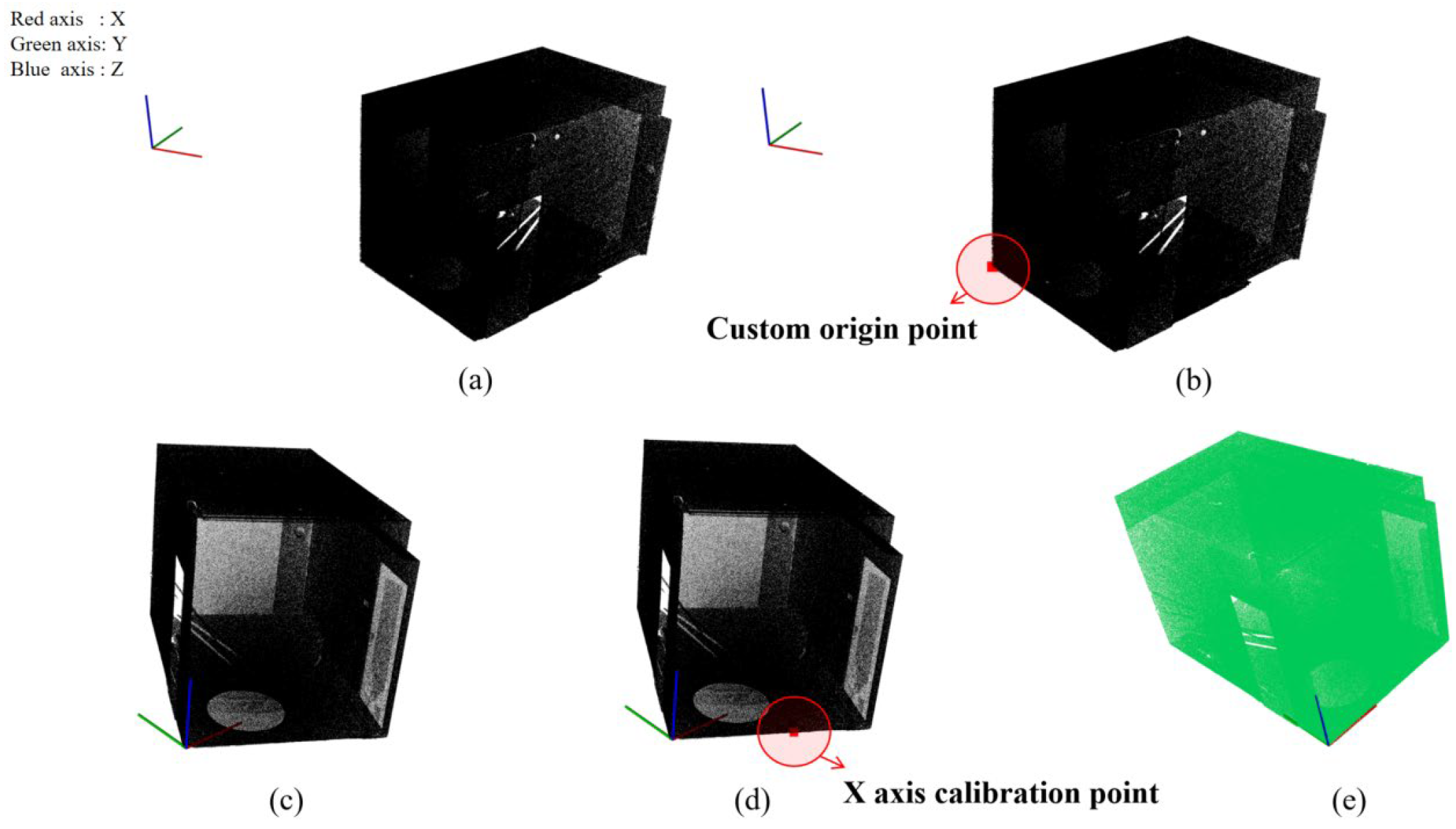
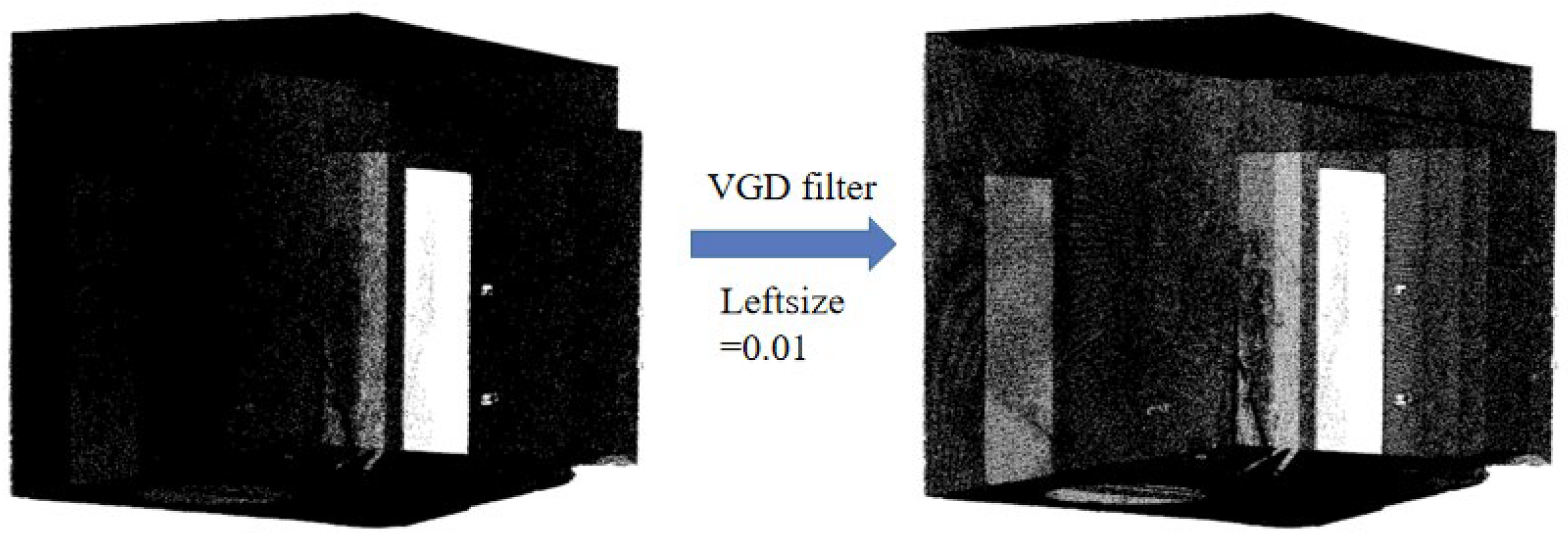
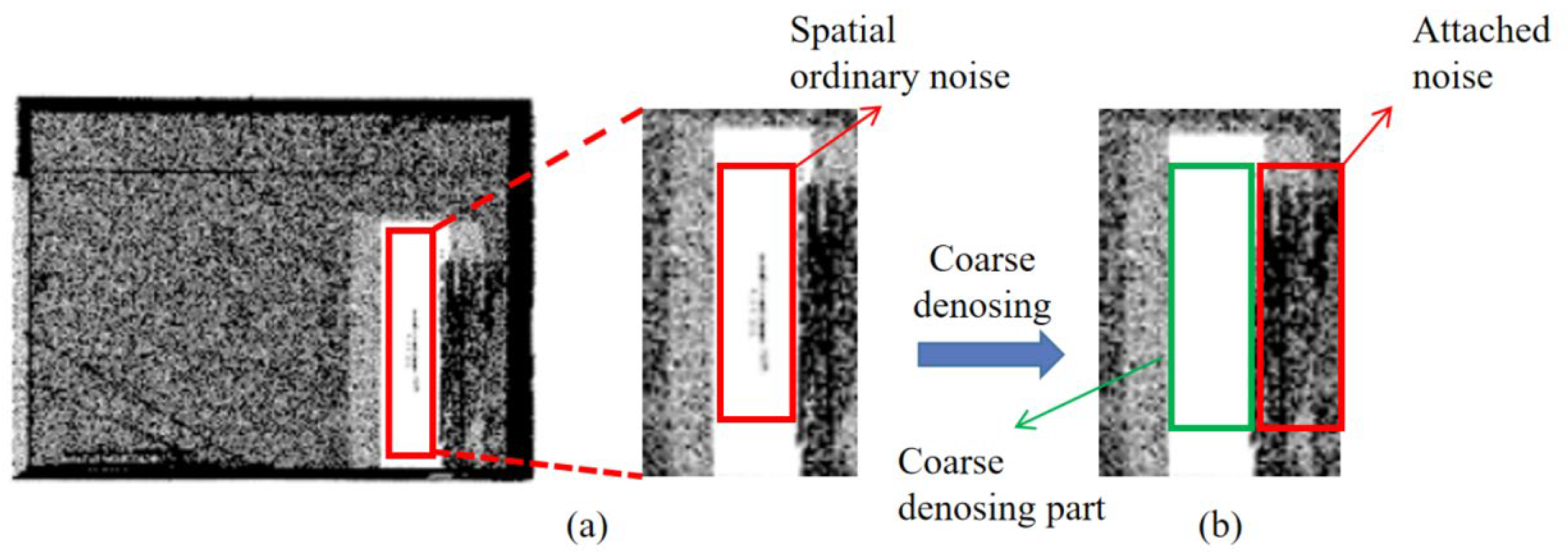
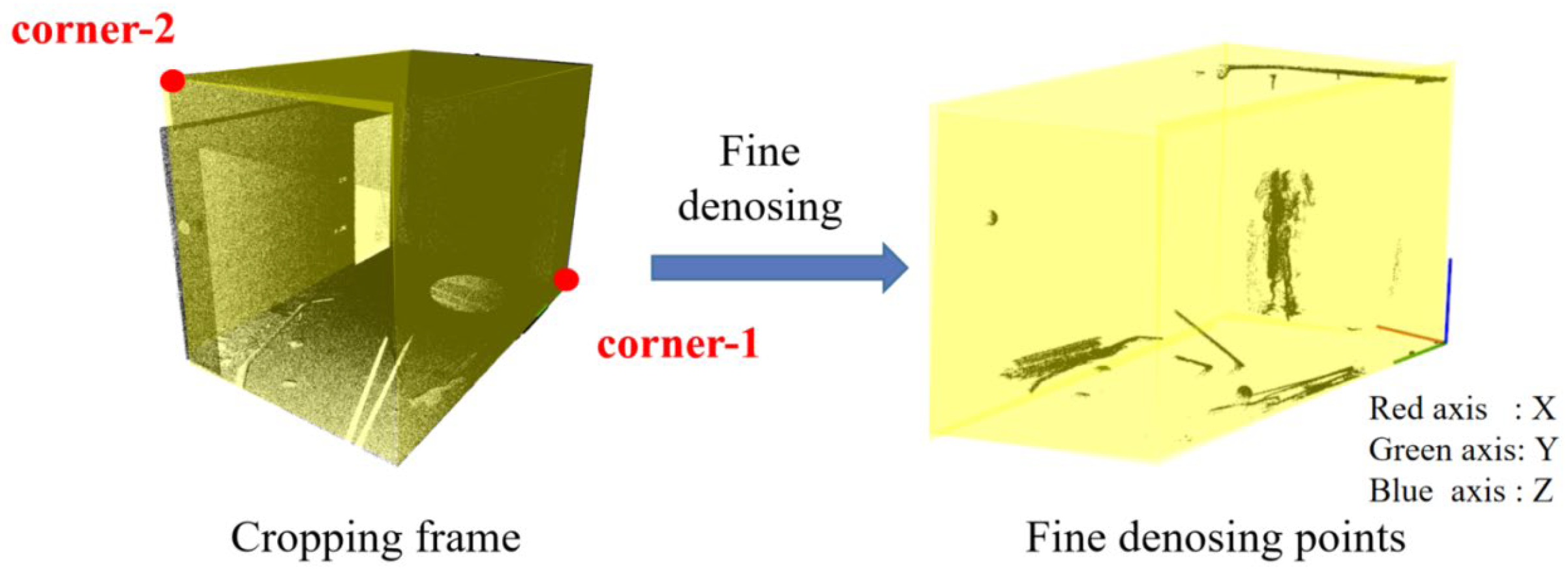


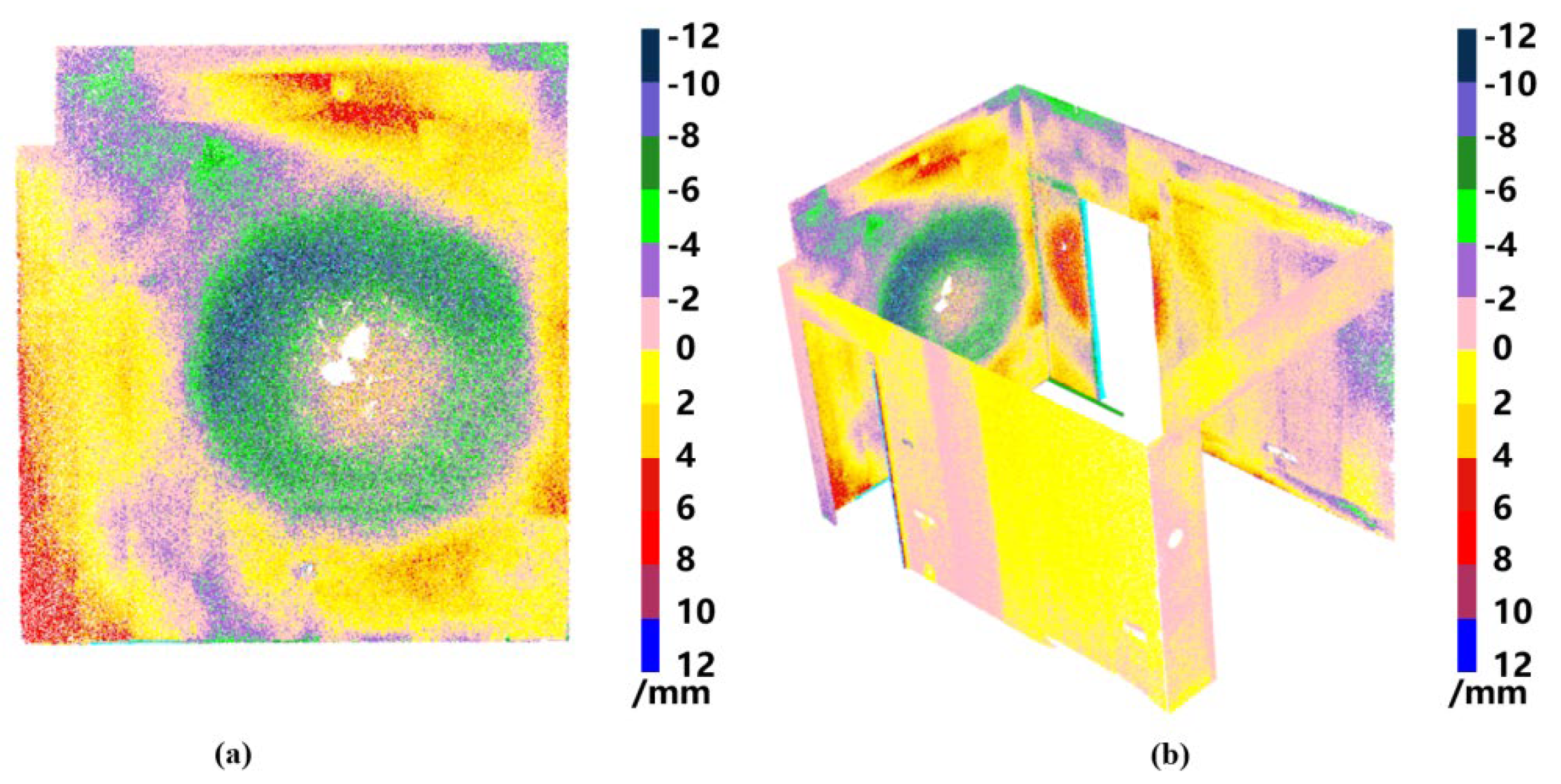
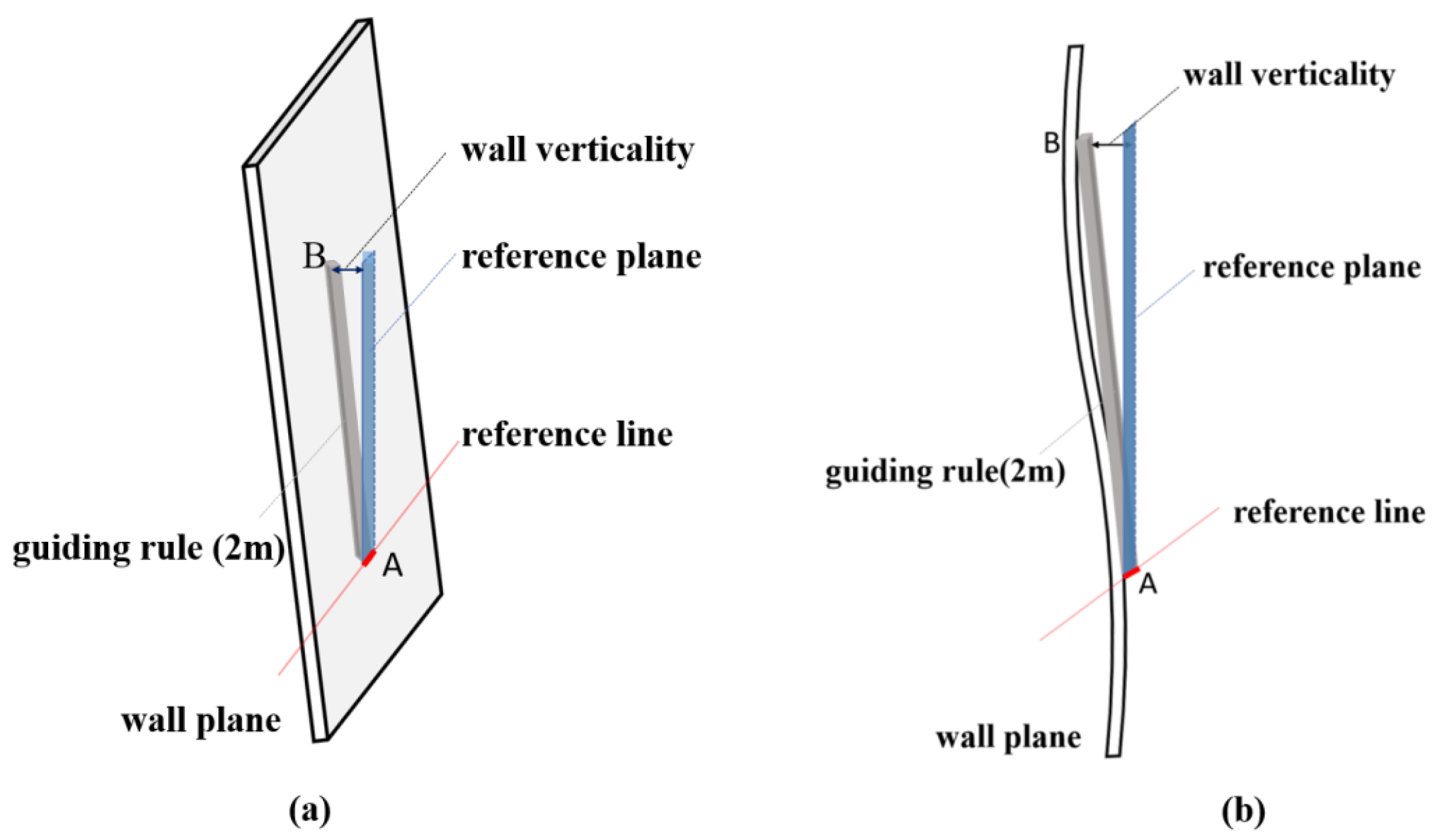
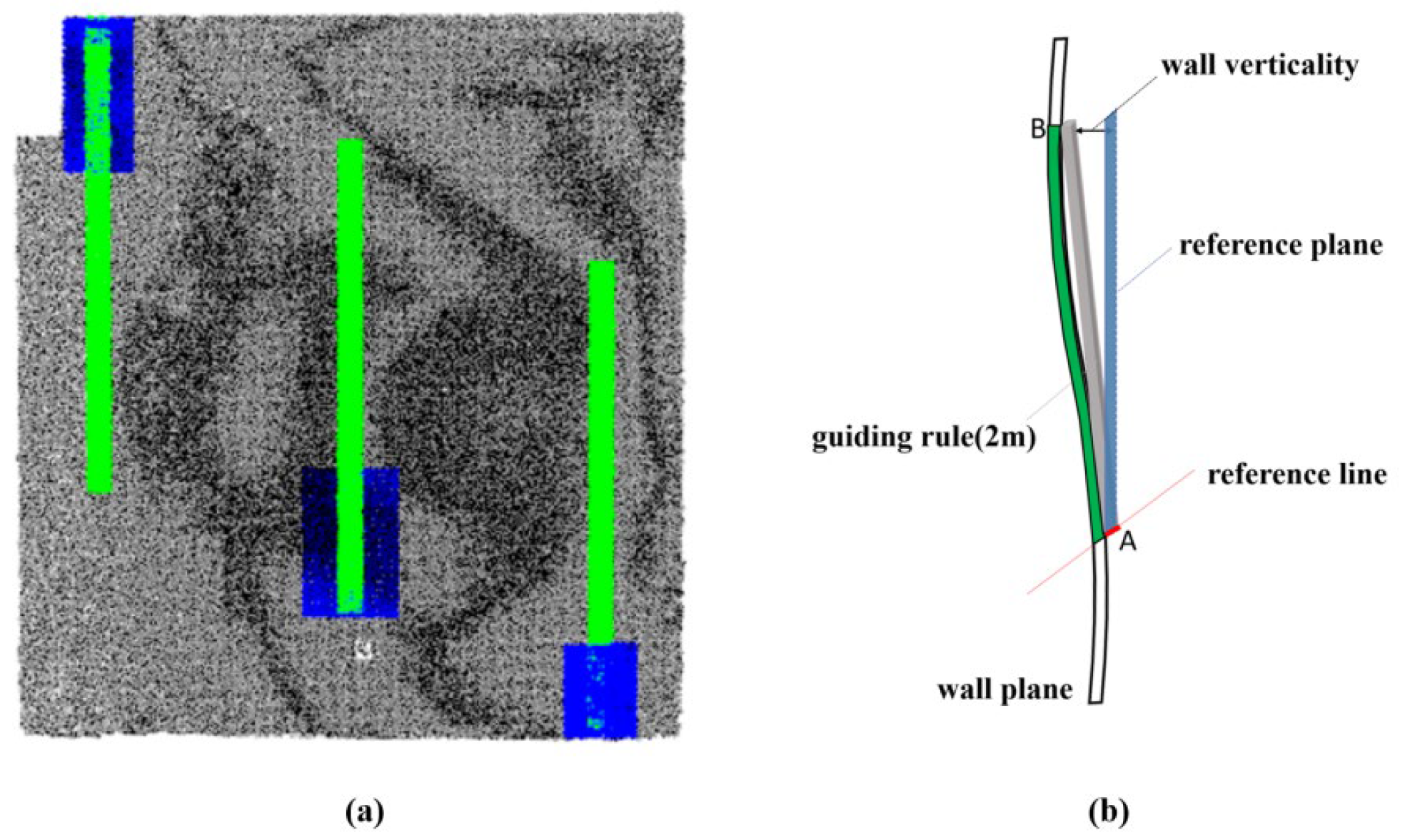
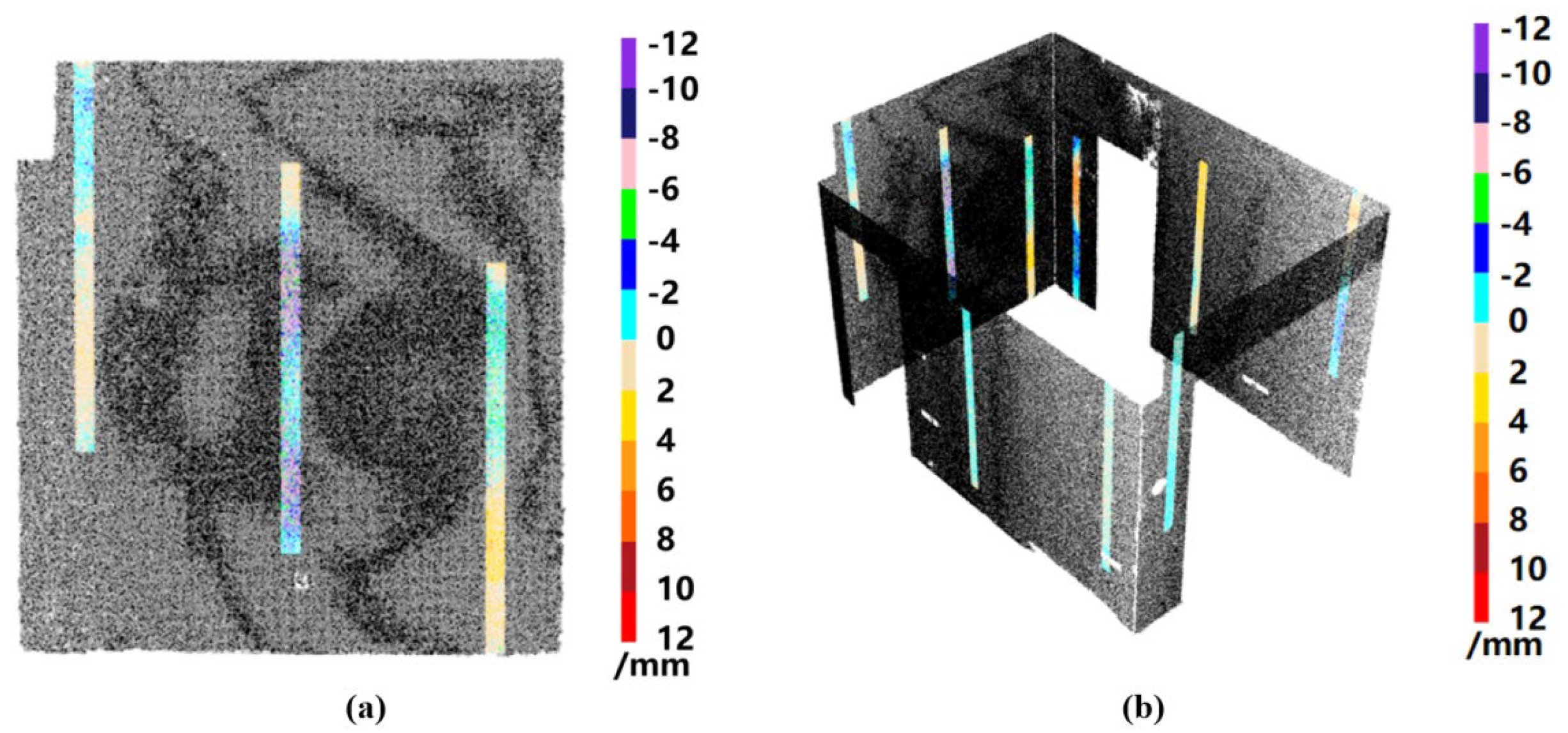


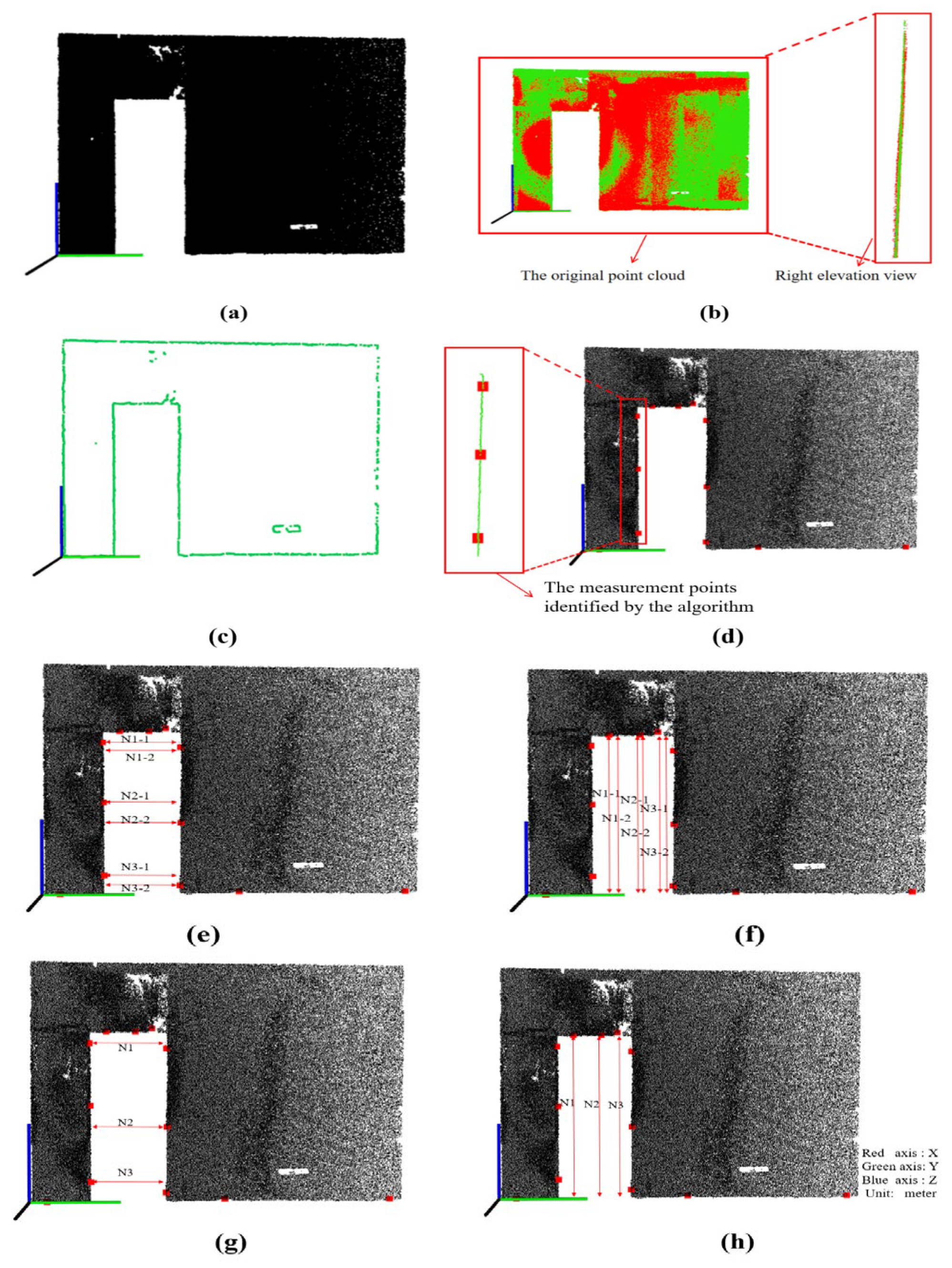
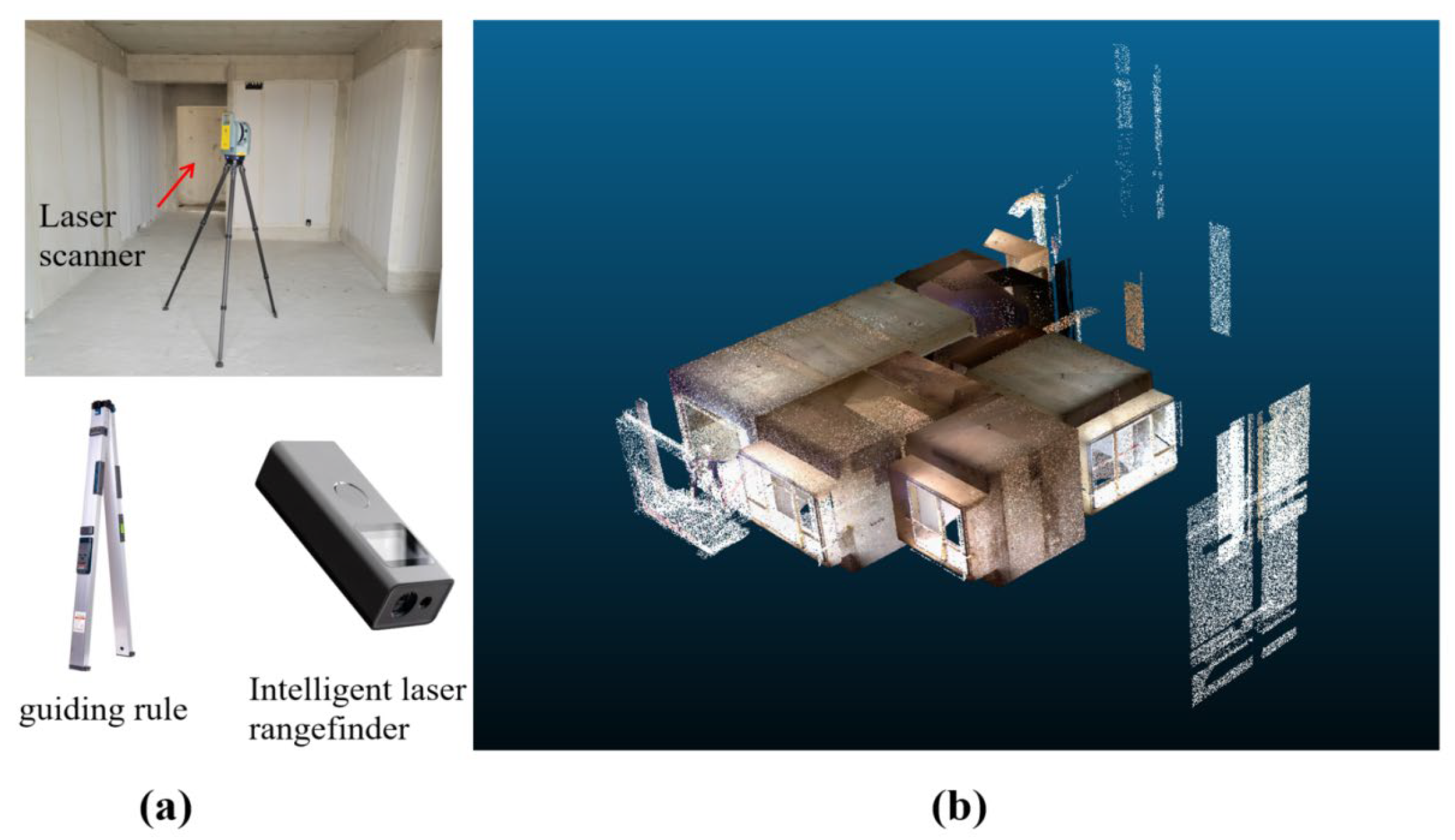
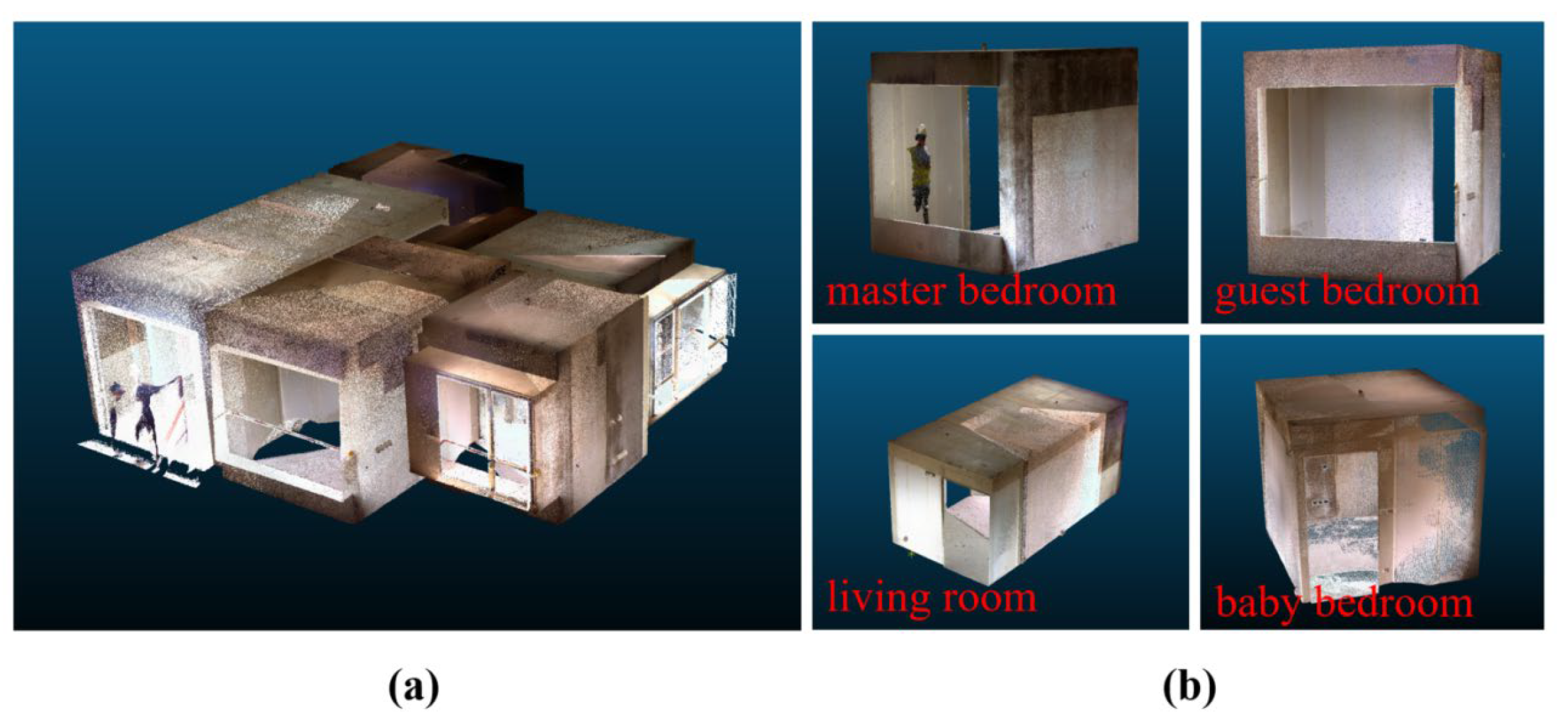
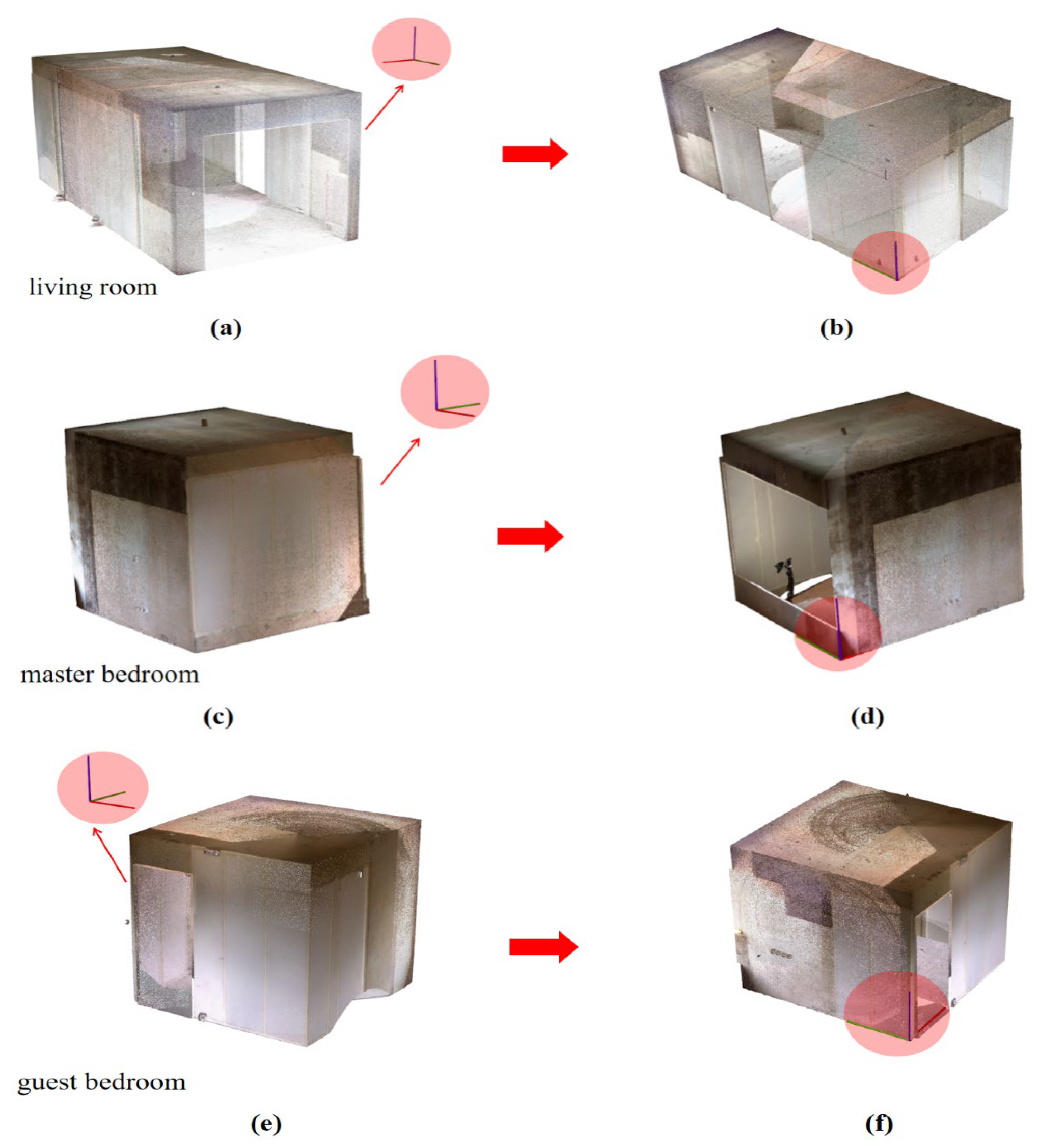

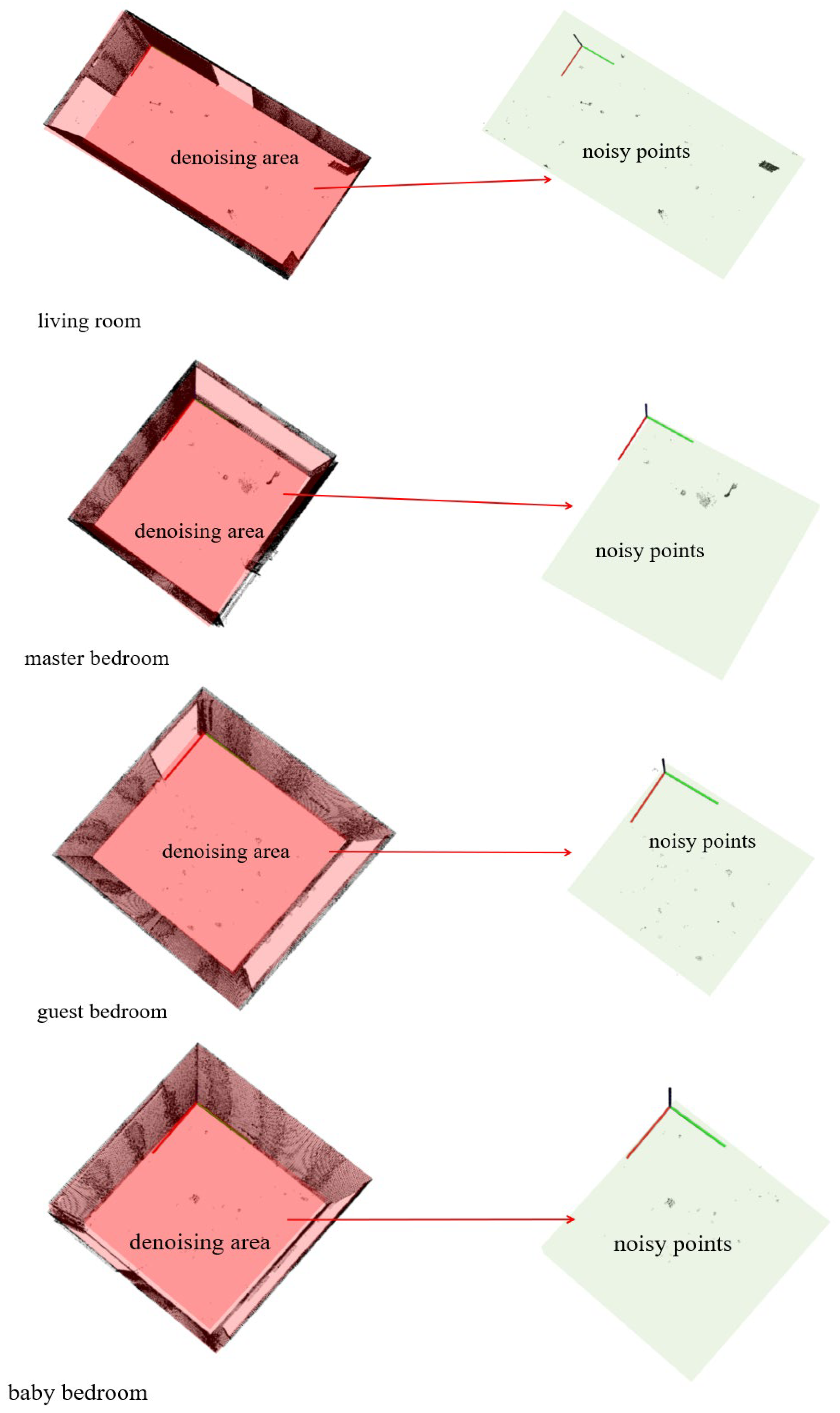

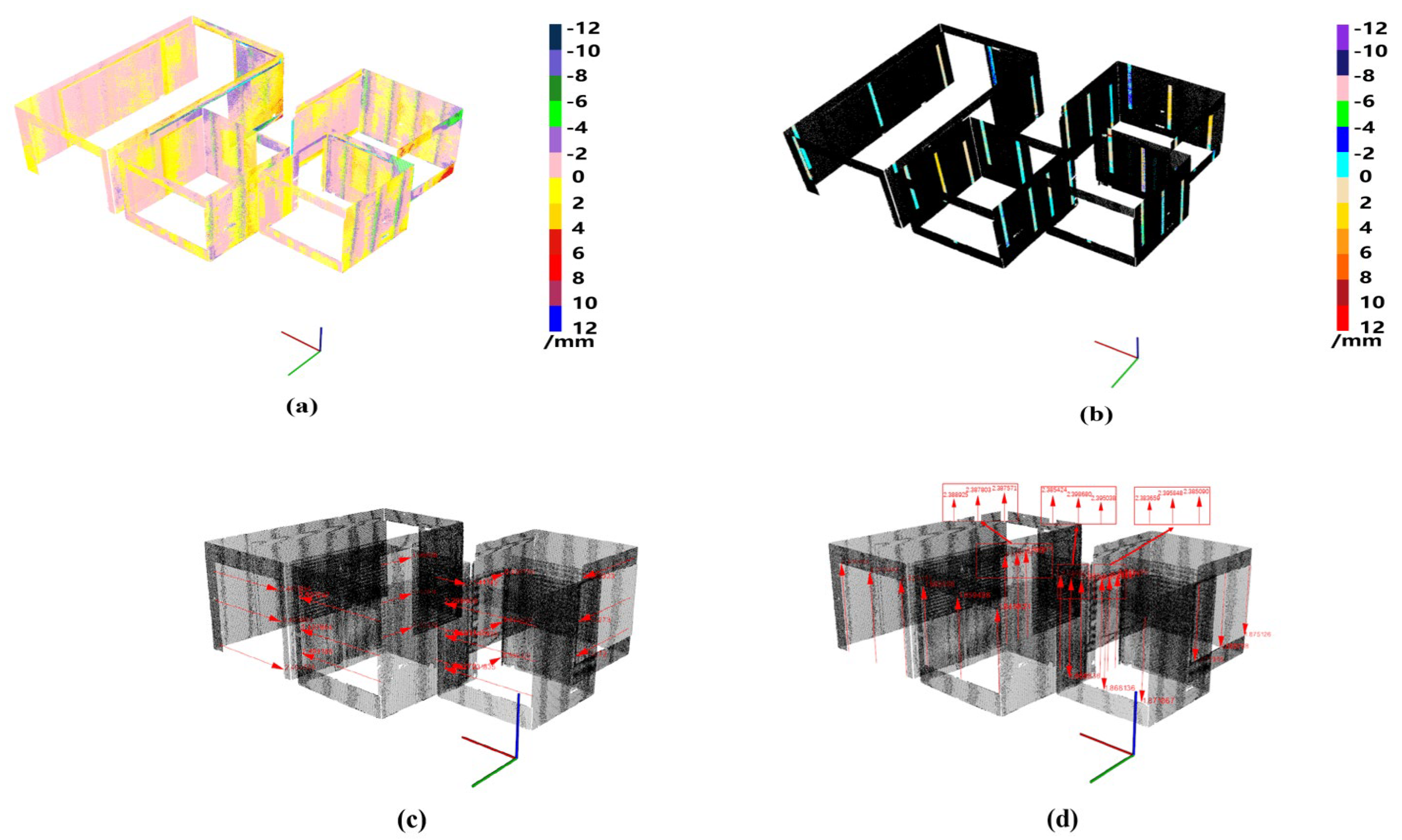
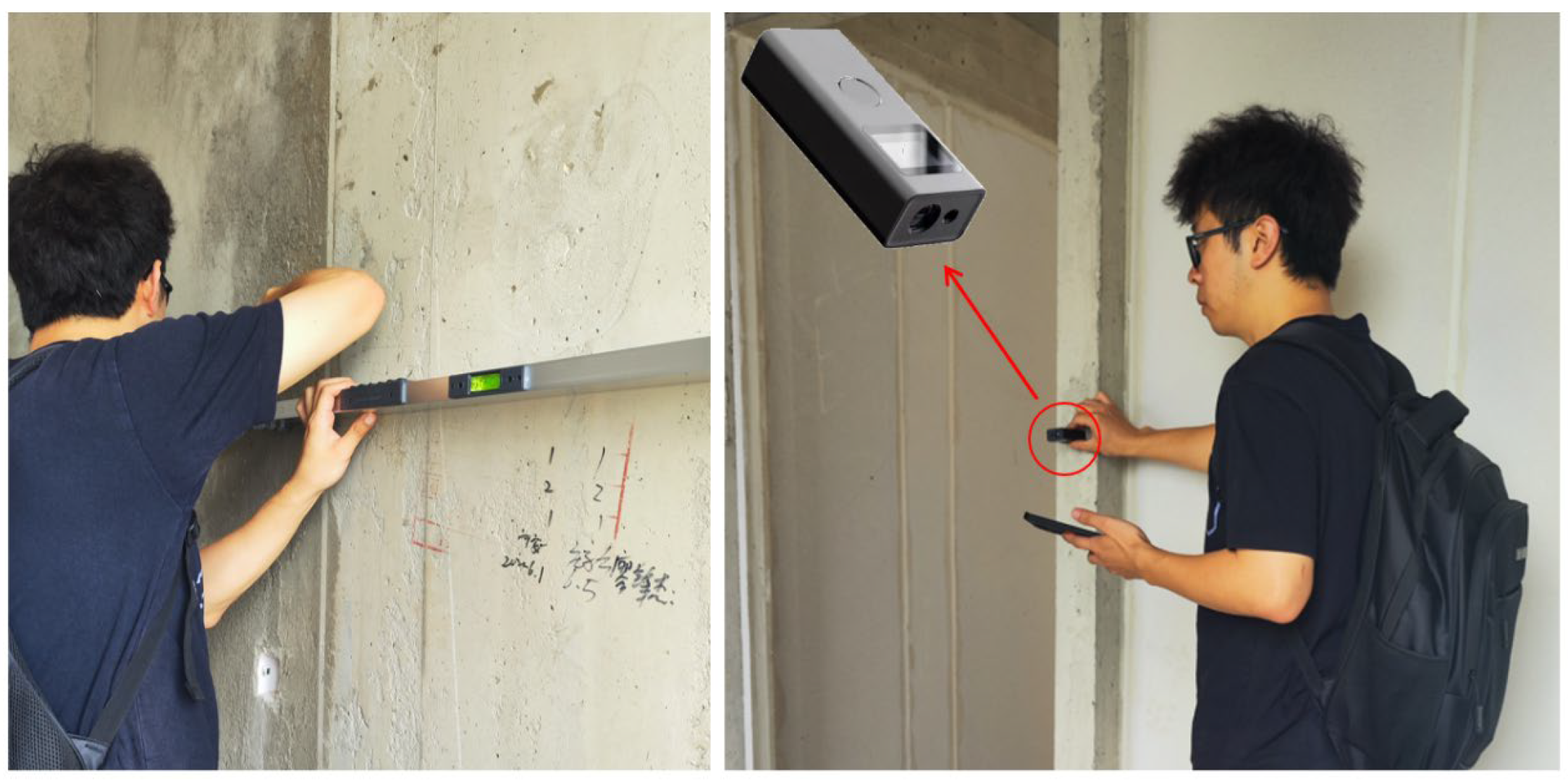

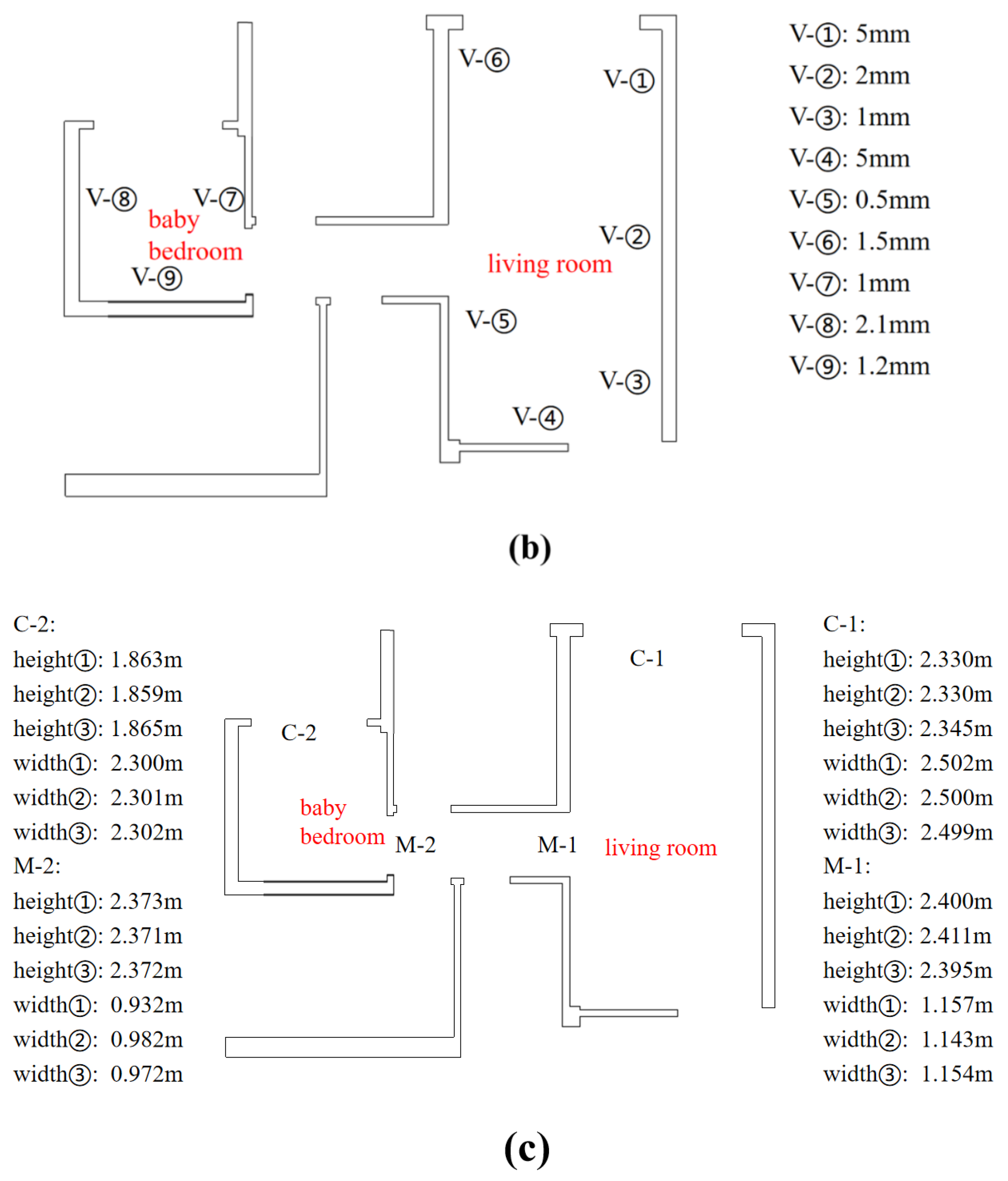
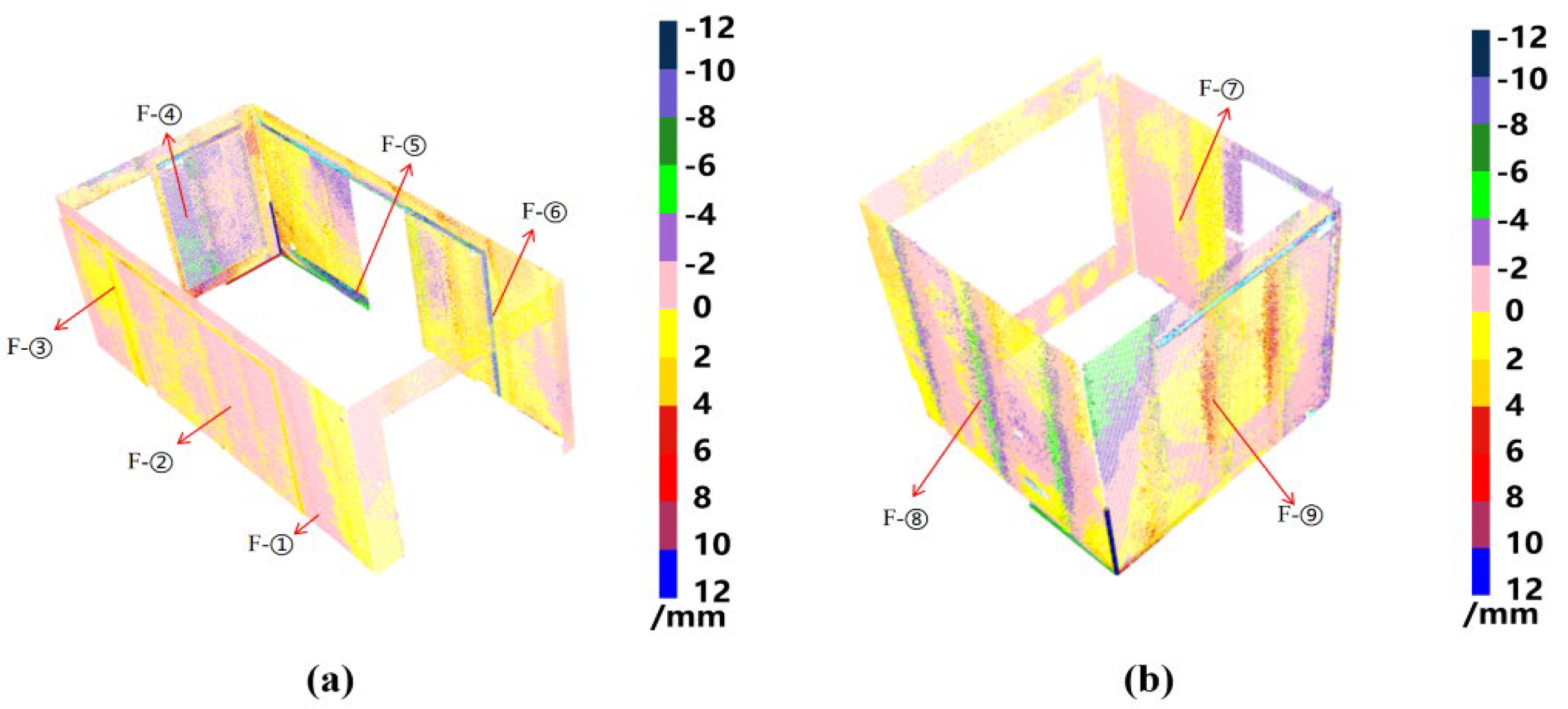
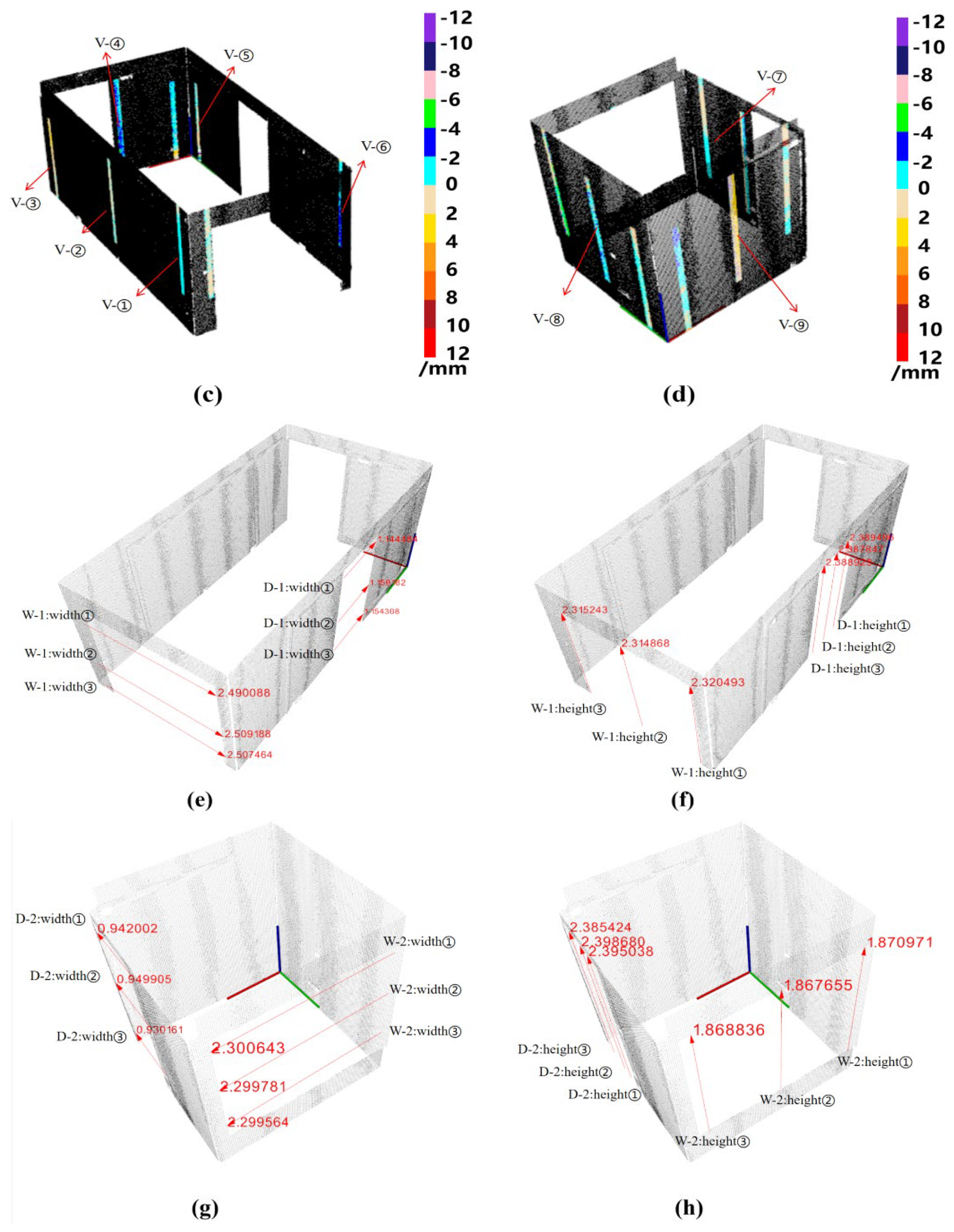
| (a) | ||||||
| Measuremen Position | Flatness/mm | Verticality/mm | ||||
| Manual | Algorithm | Error | Manual | Algorithm | Error | |
| ① | 2 | 0–2 | 0–2 | 5 | 0–2 | 3–5 |
| ② | 2 | 0–2 | 0–2 | 2 | 0–2 | 0–2 |
| ③ | 3 | 0–2 | 0–2 | 1 | 0–2 | 0–1 |
| ④ | 5 | 2–4 | 1–3 | 5 | 2–4 | 1–3 |
| ⑤ | 11.5 | 8–10 | 1–3.5 | 0.5 | 0–2 | 0.5–1.5 |
| ⑥ | 9 | 8–10 | 1 | 1.5 | 2–4 | 0.5–2.5 |
| ⑦ | 6.1 | 0–2 | 4.1–6.1 | 1 | 0–2 | 0–1 |
| ⑧ | 4.4 | 4–6 | 0.4–1.6 | 2.1 | 2–4 | 0–2 |
| ⑨ | 4.1 | 4–6 | 0–2 | 1.2 | 0–2 | 0–1 |
| (b) | ||||||
| Measurement Position | W-1/m | W-2/m | ||||
| Manual | Algorithm | Error | Manual | Algorithm | Error | |
| Height ① | 2.328 | 2.320 | <0.008 | 1.868 | 1.871 | <0.003 |
| Height ② | 2.318 | 2.314 | <0.004 | 1.876 | 1.868 | <0.008 |
| Height ③ | 2.318 | 2.315 | <0.003 | 1.867 | 1.869 | <0.002 |
| Width ① | 2.488 | 2.490 | <0.002 | 2.300 | 2.301 | <0.001 |
| Width ② | 2.502 | 2.509 | <0.007 | 2.301 | 2.300 | <0.001 |
| Width ③ | 2.512 | 2.507 | <0.005 | 2.302 | 2.300 | <0.002 |
| (c) | ||||||
| Measurement Position | D-1/m | D-2/m | ||||
| Manual | Algorithm | Error | Manual | Algorithm | Error | |
| Height ① | 2.393 | 2.389 | <0.004 | 2.395 | 2.395 | 0 |
| Height ② | 2.392 | 2.388 | <0.004 | 2.395 | 2.399 | <0.004 |
| Height ③ | 2.393 | 2.389 | <0.004 | 2.383 | 2.385 | <0.002 |
| Width ① | 1.143 | 1.144 | <0.001 | 0.938 | 0.942 | <0.004 |
| Width ② | 1.160 | 1.159 | <0.001 | 0.960 | 0.950 | <0.010 |
| Width ③ | 1.154 | 1.154 | 0 | 0.935 | 0.930 | <0.005 |
| Residence | Preprocessing | Flatness | Verticality | Opening Dimensions | Total Time |
|---|---|---|---|---|---|
| The proposed method | 15 min | 3.5 min | 4 min | 6 min | 28.5 min |
| Manual measurement | / | 18 min | 18 min | 20 min | 56 min |
Disclaimer/Publisher’s Note: The statements, opinions and data contained in all publications are solely those of the individual author(s) and contributor(s) and not of MDPI and/or the editor(s). MDPI and/or the editor(s) disclaim responsibility for any injury to people or property resulting from any ideas, methods, instructions or products referred to in the content. |
© 2023 by the authors. Licensee MDPI, Basel, Switzerland. This article is an open access article distributed under the terms and conditions of the Creative Commons Attribution (CC BY) license (https://creativecommons.org/licenses/by/4.0/).
Share and Cite
Tan, Y.; Liu, X.; Jin, S.; Wang, Q.; Wang, D.; Xie, X. A Terrestrial Laser Scanning-Based Method for Indoor Geometric Quality Measurement. Remote Sens. 2024, 16, 59. https://doi.org/10.3390/rs16010059
Tan Y, Liu X, Jin S, Wang Q, Wang D, Xie X. A Terrestrial Laser Scanning-Based Method for Indoor Geometric Quality Measurement. Remote Sensing. 2024; 16(1):59. https://doi.org/10.3390/rs16010059
Chicago/Turabian StyleTan, Yi, Xin Liu, Shuaishuai Jin, Qian Wang, Daochu Wang, and Xiaofeng Xie. 2024. "A Terrestrial Laser Scanning-Based Method for Indoor Geometric Quality Measurement" Remote Sensing 16, no. 1: 59. https://doi.org/10.3390/rs16010059
APA StyleTan, Y., Liu, X., Jin, S., Wang, Q., Wang, D., & Xie, X. (2024). A Terrestrial Laser Scanning-Based Method for Indoor Geometric Quality Measurement. Remote Sensing, 16(1), 59. https://doi.org/10.3390/rs16010059








